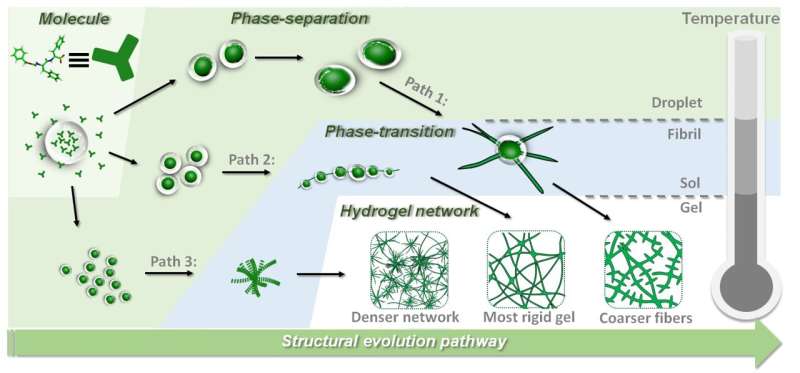This article has been reviewed according to Science X's editorial process and policies. Editors have highlighted the following attributes while ensuring the content's credibility:
fact-checked
peer-reviewed publication
trusted source
proofread
Steering phase-separated droplets to control mechanical properties of supramolecular peptide hydrogels

Self-assembled peptide supramolecular hydrogels have shown great application prospects in various areas, including tissue engineering, drug delivery, and biosensing.
Precisely and flexibly controlling the mechanical properties of peptide hydrogels to match the targeted applications is important. The common methods to regulate the mechanical properties of supramolecular hydrogels generally include: changing the formula (different peptide sequences, adding cross-linking agents) or changing the environmental conditions (concentration, temperature, pH and ions), both of which inevitably change the chemical composition of the hydrogel.
Now, researchers from the Institute of Process Engineering (IPE) of the Chinese Academy of Sciences have explored strategies to control the mechanical properties of hydrogels by using the liquid–liquid phase separation (LLPS)-mediated self-assembly principle without changing the chemical composition of hydrogels.
The study was published in Matter.
In the preparation of hydrogels, the number and size of phase-separated droplets are well-controlled in the early stage of self-assembly in order to tune the nanostructure of self-assembled precursors. These precursors can be urchin-like fibrils, beaded spindle-like fibrils, or radial fibril clusters.
When it comes to further fibril growth and formation of a non-covalent cross-linking network, the structural difference between precursors leads to a difference in fibril diameter, number of fibrils, and cross-linking density of the network, thus forming hydrogel materials with different mechanical strength and recoverability.
The researchers found that tuning incubation temperature and time through process sequencing could control the self-assembled precursors. An optimal initial incubation temperature could lead to optimal mechanical strength and recoverability when the chemical composition of the hydrogel remained unchanged. The optimal initial temperature was precisely the temperature at which the droplets were transformed into nanofibrils.
They further confirmed through experiments and molecular simulation that at the phase transition temperature, peptide molecules showed a strong aggregation propensity, de-solvation effect, and dynamic metastable hydrogen bonding, which was conducive to fibril branching, thus enabling the hydrogel to obtain the best nanofibril strength and cross-linking density under the condition of constant concentration.
More information: Xuehai Yan & collegaues, Steering phase-separated droplets to control fibrillar network evolution of supramolecular peptide hydrogels, Matter (2023). DOI: 10.1016/j.matt.2023.03.029. www.cell.com/matter/fulltext/S2590-2385(23)00131-5
Journal information: Matter
Provided by Chinese Academy of Sciences




















